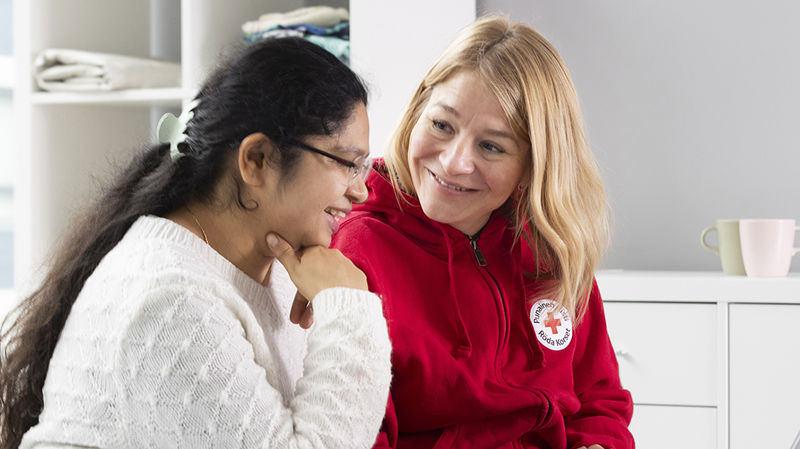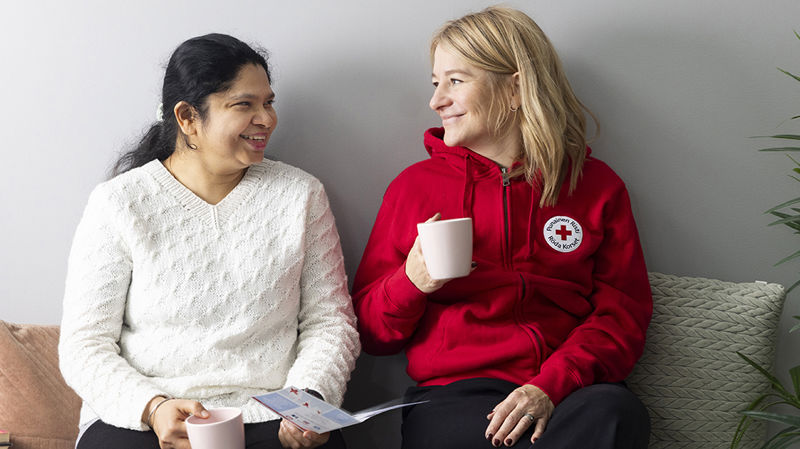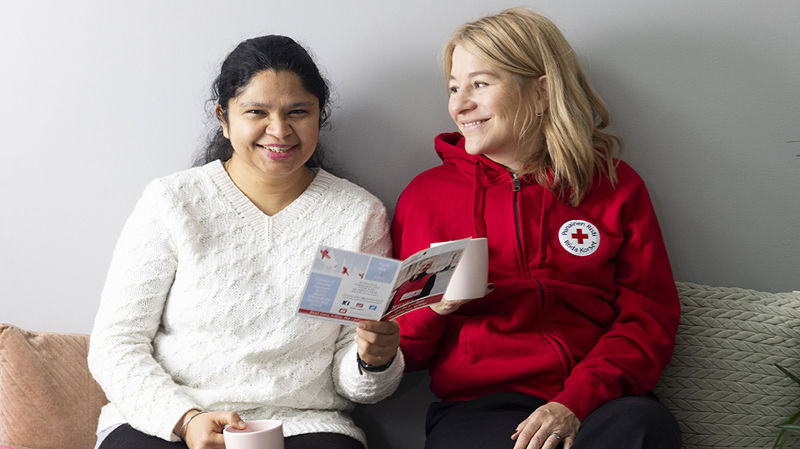
Finnish Red Cross visual communications
The Finnish Red Cross uses a wide range of visual materials in its communications. On this page, you will find instructions to help you create and use imagery in a coherent way.
Our aim is to create an image of a world where we stand up for humanity, dignity and equality. We are constantly improving our visual storytelling through feedback and measurement. Visual storytelling techniques are constantly evolving, and these instructions will be updated as necessary.
These instructions focus on photographs and illustrations, but the same principles can also be applied to the production and use of moving images.
Note: campaign imagery may differ from these instructions.
The example pictures are owned by the Finnish Red Cross unless otherwise stated.
Each visual element shapes the image of the Red Cross. We want to show that we are a genuine, safe and competent organisation that is a part of your everyday life, but we also act quickly when needed. We encounter people boldly, even in challenging situations.
Just like our work, our images also focus on people. We capture the connection of one person to another and highlight the importance of human interaction. We present each and every person as equally valuable and capable. We show that anyone can need help or help others. We actively highlight diversity.
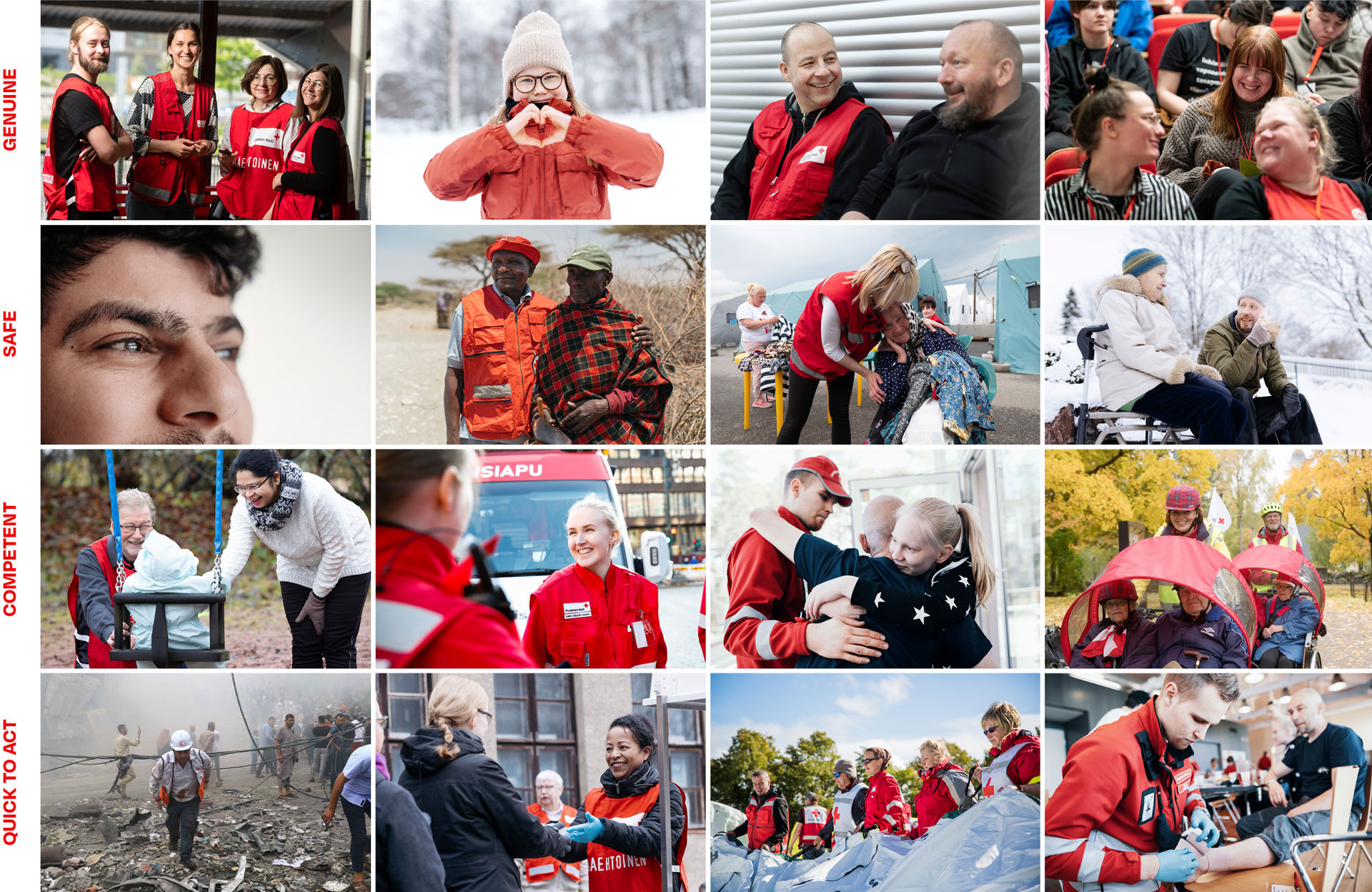
Our images show the diversity of our activities: aid operations, organisation activities, voluntary service, and crises and disasters. The images are designed and selected with our different target groups in mind: volunteers, supporters, partners and the media. We also use images to tell stories about everyday life and social phenomena, and to support people’s ability and willingness to help themselves and others. In some cases, we are communicating to the so-called general public. In these cases, special attention is paid to accessibility and appropriate tone of voice.
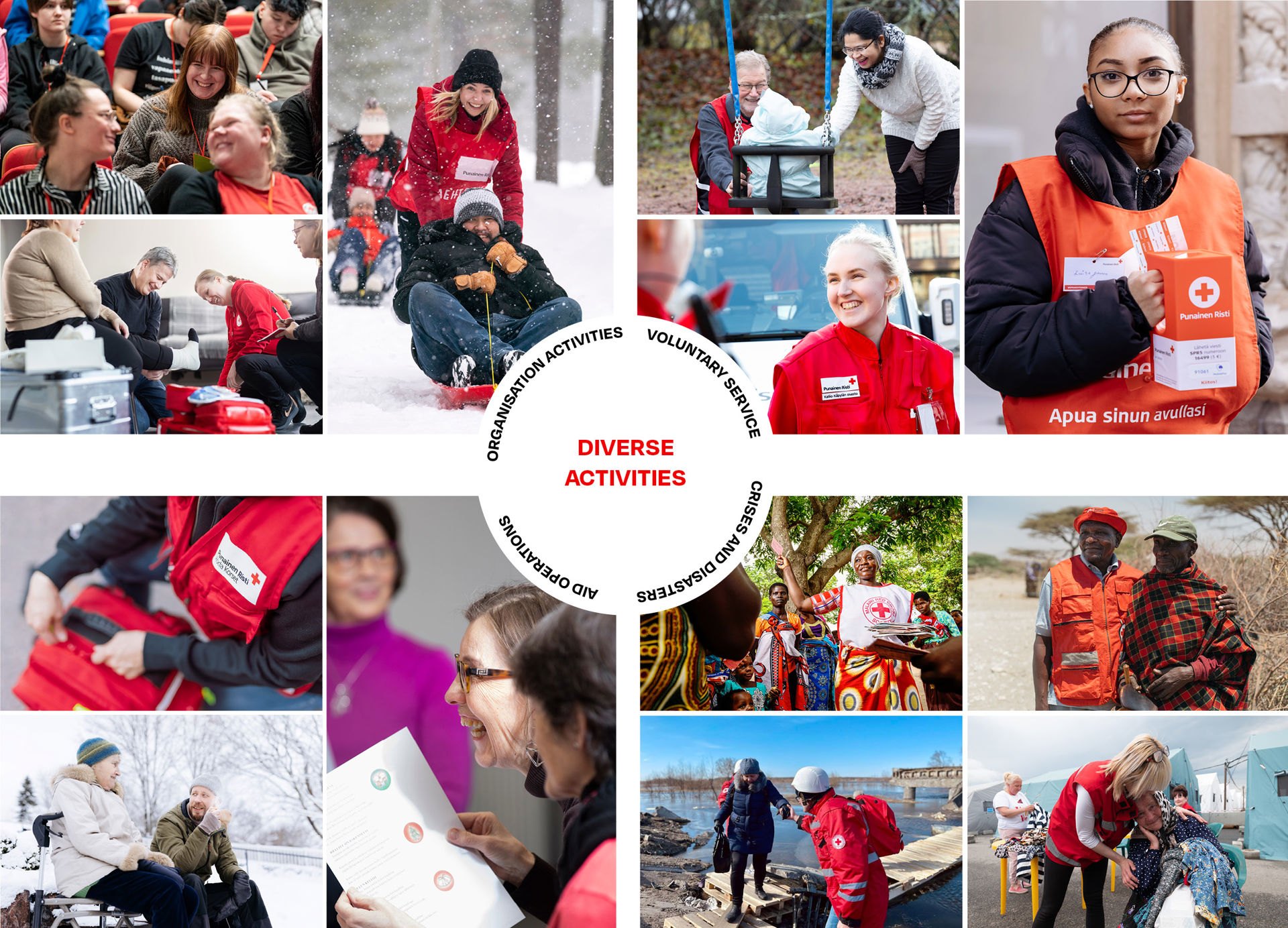
We want to show the world as it is. Our aim is to create a natural, fresh and contemporary imagery with a sense of movement.
Movement
We reinforce the image of our organisation as an efficient and action-oriented operator by creating movement in the images through composition, cropping and angle.
Style
The style of the images is documentary. In campaign imagery, the style may also be conceptual.
Lighting
We use as much natural light as possible. During the dark seasons and indoors, we use enough lighting to achieve a sense of freshness, but as naturally as possible. We avoid filters, strong shadows, silhouettes, flash and post-processing, except for colour.
Composition
In pictures, we are close to the person or the subject of the picture. Our pictures have a clear focus, and we use depth of field to emphasise this. We avoid general pictures. We do not put ourselves above anyone, not even in pictures.
Colours
The aim is to reproduce colours in a natural way. When appropriate, the colour red is taken into account in clothing, surroundings or equipment. However, red is not the main thing — it is a seasoning to be used when it comes naturally.





Community level
With community-level images, we communicate the organisation’s local activities. They are used in local materials and media, such as branch brochures and social media channels. The images show the variety of activities and the diversity of local communities. The images are produced locally by local staff and volunteers, as well as professional photographers. The headquarters support the production of images.
Brand level
The aim of brand-level images is to attract people to the activities and generate visibility. The images boost the brand voice of the organisation. The images show diverse activities, social phenomena and everyday life. The images also support people’s ability and willingness to help themselves. The images are produced by selected professional photographers.
Reportage level
With our reportage-level photos, we provide information on our global operations. The photos are journalistic documentation. They focus on substance and information. The photos show our work in crisis and disaster areas and our development cooperation projects. The style of the photos varies and can even be rough, but they are always produced responsibly. The photos are produced by trained professional photographers from the photographer network. We also make use of images from the International Red Cross and Red Crescent Movement, including the International Federation of Red Cross and Red Crescent Societies (IFRC), the International Committee of the Red Cross (ICRC) and the movement’s national societies.
We want to depict the help we give and the hope our work brings. We work with vulnerable people, and this requires special attention when designing and using images.
The images of our aid operations at home and abroad differ in content, but we follow the same principles in both:
- We respect everyone’s dignity. We follow the ‘do no harm’ principle, meaning that we ensure that our well-intentioned actions do not cause harm to vulnerable people, even by accident.This transcends any communication, fundraising or other needs.
- We value diversity by default and challenge stereotypes. We present everyone as equals.
- We present the full picture. We do not exclude anything relevant to the person or their situation that might change the viewer’s interpretation.
- Informed consent. We protect the privacy of everyone in the picture in accordance with their wishes. We amplify the voice of everyone’s story.
- Our activities are based on knowledge. We act based on the best knowledge and understanding available at the time.
- We ensure the safety of everyone involved. Our activities must not put anyone in danger.



Our work involves subjects and population groups whose visual presentation requires special attention.
We try to use visual expressions that convey competent help and compassionate support, while avoiding clichés. We show everyone as individuals, but allow for anonymity where necessary.



We encounter and photograph children in the same way around the world. Special discretion must be exercised when photographing children or using images of children. Our role is first and foremost to protect children, but also to provide information about events and phenomena that affect their lives. Like adults, children are presented as capable actors in their own lives.



In our images of crises, disasters and conflicts, we make sure that the people photographed get the help they need. We show that we act quickly and are there to help people. The tone of the images is serious, reassuring and hopeful.
In international crisis situations, the presence of a Red Cross volunteer or employee in the picture reinforces the message that the Red Cross is active in the affected area. The main focus of the pictures is on local workers and volunteers, just as it is on site.
All aid recipients in the photos have a face, name and story, unless showing them would put the recipient in danger or cause harm.



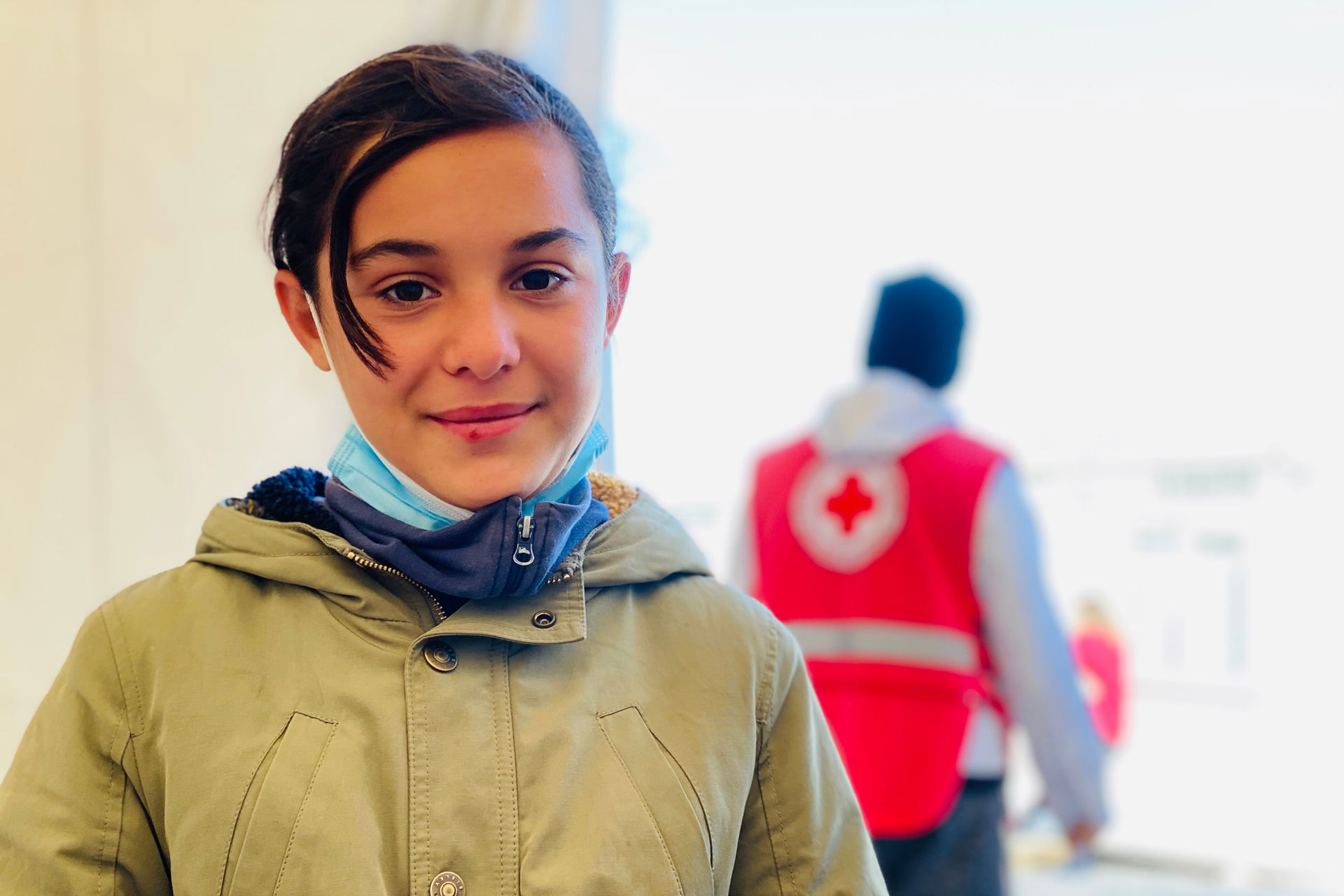
Carefully designed and executed illustrations bring versatility to visual communication and expression. Illustrations also allow difficult and abstract topics to be dealt with in an easy, approachable and understandable way.
The Communications Services unit helps with the production of illustrations. Please contact aineistot@redcross.fi.

There are many ways to acquire images: by downloading from the Finnish Red Cross Material Bank, by taking a photo yourself, by ordering a photo from a photographer or by using free image banks. To ensure image quality and protect copyright, we recommend using images from the Finnish Red Cross Material Bank in the organisation’s communications.
Copying or using images without permission may infringe copyright. Using images in a context other than the original can also cast the people in the image in an unfavourable light.
Information about the photographer must be indicated on the image or in close proximity to it.
The images in the Material Bank support the goals of our operations, communications and fundraising. Images on other topics can be obtained from various image banks, such as Unsplash or Pixabay, which offer free images. Please take the image use policy into account also when selecting and using images from image banks.
The Communications Services unit helps with the use and production of images and illustrations: aineistot@redcross.fi.
